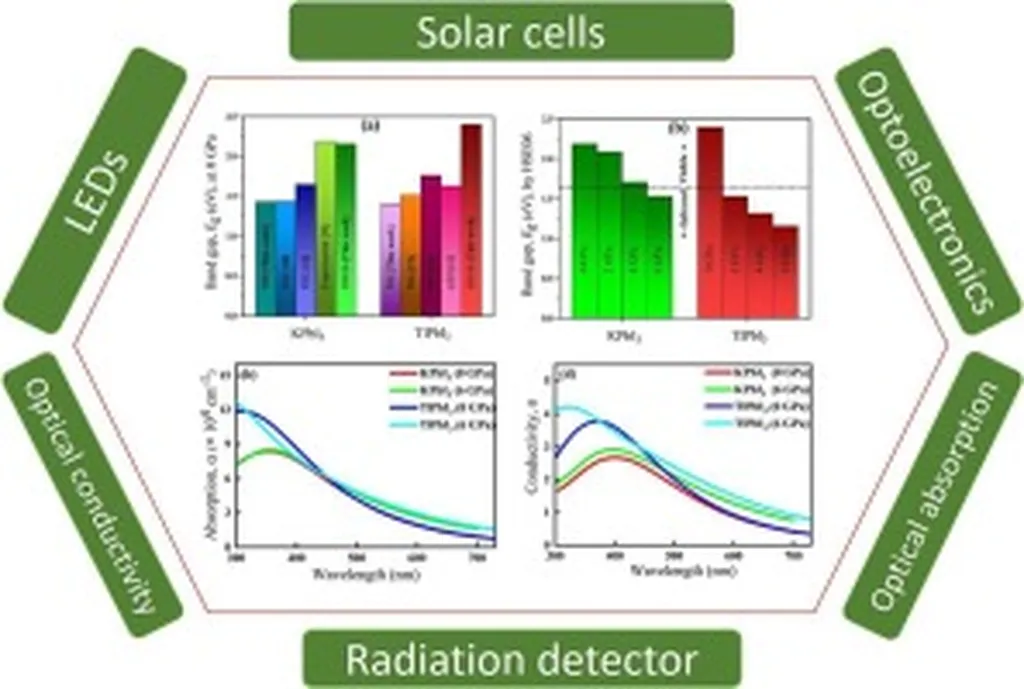In a significant stride towards enhancing the performance of optoelectronic devices, researchers have uncovered the potential of inorganic metal halide perovskites, specifically ASnF3 (A = K, Rb), under applied pressure. This groundbreaking study, led by Md N.J. Rifat from the Department of Materials Science and Engineering at Khulna University of Engineering & Technology (KUET) in Bangladesh, delves into the fundamental physical properties of these compounds, offering insights that could revolutionize the energy sector.
The research, published in ‘Results in Materials’ (which translates to ‘Results in Materials’ in English), employs density functional theory (DFT) to investigate the behavior of ASnF3 perovskites under hydrostatic pressure. The primary objective is to modulate their distinct physical characteristics, particularly focusing on the reduction of the electronic band gap. “By applying pressure, we can enhance the atomic contact within the lattice, leading to a more efficient conduction spectrum,” explains Rifat. This enhancement is crucial for optoelectronic applications, as it directly impacts the performance of devices such as solar cells and LEDs.
The study confirms the structural, thermodynamic, and mechanical stabilities of these compounds using the Goldschmidt tolerance factor, formation energy, and Born stability criteria, respectively. Additionally, the lattice dynamical stability is verified through phonon dispersion curve analysis. The calculated lattice constant of RbSnF3 (4.77 Å) aligns closely with previously reported values, underscoring the accuracy of the findings.
One of the most compelling aspects of this research is the observation of how applied pressure influences the band gap of these perovskites. Within the 0–9 GPa pressure range, the band gap of KSnF3 diminishes from 1.838 eV to 1.100 eV, while RbSnF3’s band gap reduces from 1.835 eV to 1.010 eV. “This reduction in band gap is a direct result of enhanced atomic contact, which improves the conduction spectrum and optical properties,” Rifat notes. The analysis of the projected density of states (PDOS) and total density of states (TDOS) further elucidates the electronic contributions within each compound under applied pressure.
The optical properties of these compounds also exhibit significant variations due to applied pressure, making them more efficient for optoelectronic devices. The mechanical properties of the compounds reflect their ductile and anisotropic characteristics, both of which are significantly influenced by external pressure. The elastic functions analysis indicates that these compounds become even more versatile for various potential applications when subjected to hydrostatic pressure.
The hardness (HV) values follow the trend RbSnF3 > KSnF3, whereas the machinability index (B/C44) exhibits the opposite trend, with KSnF3 > RbSnF3 across the entire applied pressure range. These findings highlight the potential for tailoring the mechanical properties of these perovskites for specific applications.
The implications of this research are far-reaching, particularly for the energy sector. The enhanced optoelectronic performance of ASnF3 perovskites under pressure could lead to more efficient solar cells and LEDs, contributing to the development of sustainable energy solutions. “Our study provides a foundation for future research into non-toxic halide perovskite materials,” Rifat concludes. “We hope that this investigation will inspire further exploration and innovation in this exciting field.”
As the world continues to seek cleaner and more efficient energy sources, the insights gained from this research could pave the way for significant advancements in optoelectronic technologies. The study not only sheds light on the fundamental properties of ASnF3 perovskites but also opens up new avenues for their application in the energy sector, ultimately contributing to a more sustainable future.

